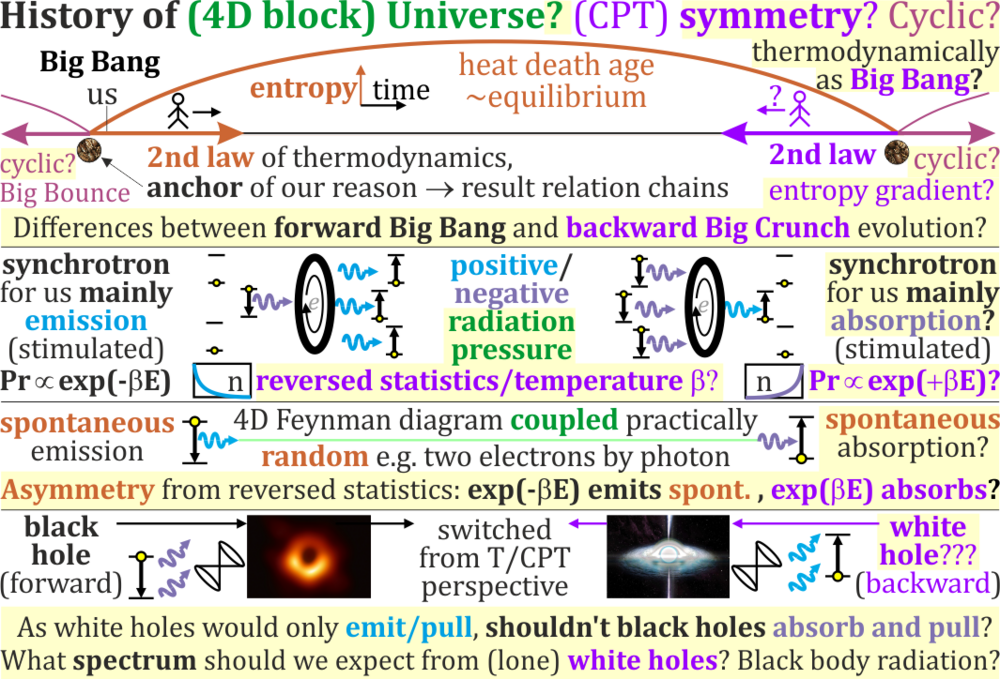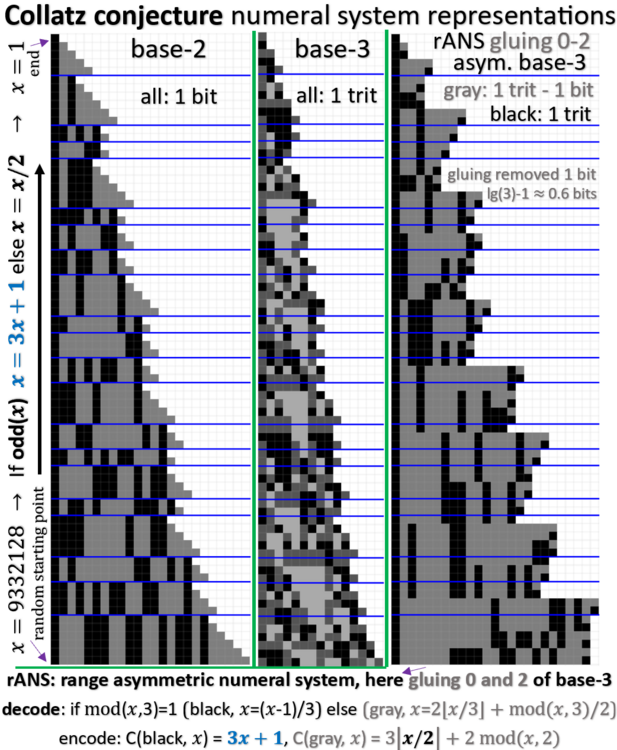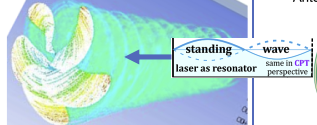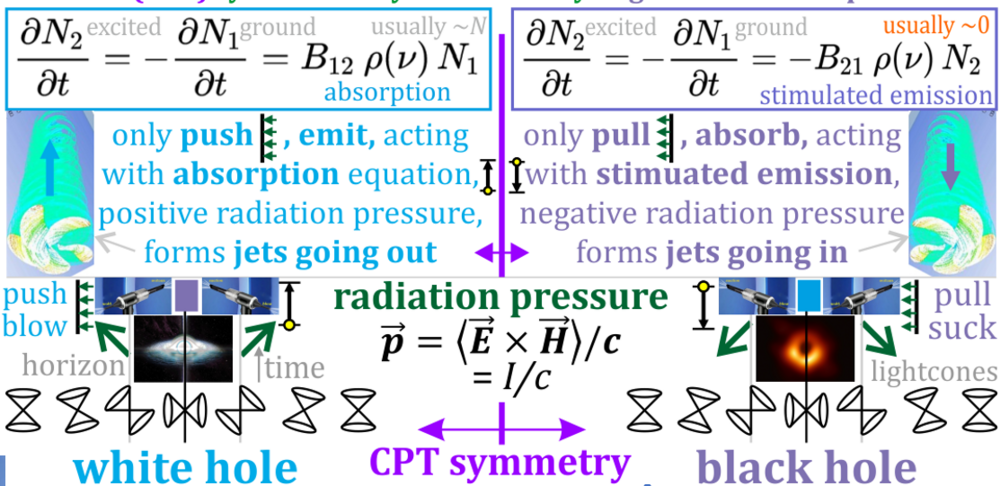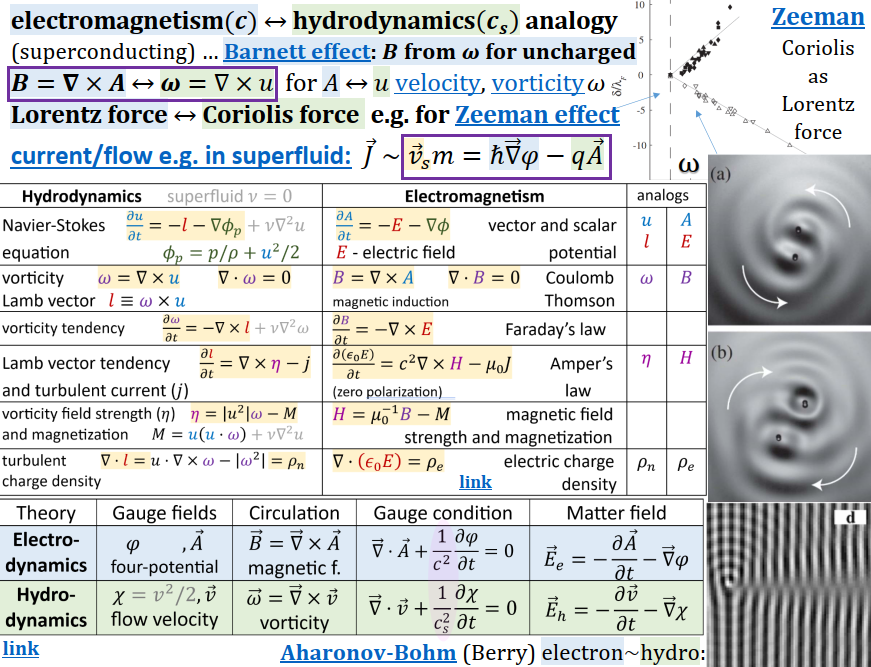Everything posted by Duda Jarek
-
Why circulating electron loses energy, as in CPT perspective it is also circulating charge gaining energy instead?
Yes, they are not the same - against CPT symmetry, the question is: why? I think because there is now more absorbers than emitters - do you agree, or have a different answer?
-
Why circulating electron loses energy, as in CPT perspective it is also circulating charge gaining energy instead?
Electrons circling due to magnetic field, in CPT perspective become positrons circling in the opposite direction. But CPT symmetry says that both are governed by the same equations - so why the former loses energy, but applying symmetry it gains energy instead? I am not neglecting this obviously observed asymmetry, but ask where it comes from?
-
Why circulating electron loses energy, as in CPT perspective it is also circulating charge gaining energy instead?
While physics is believed to be CPT symmetric in equations, this symmetry is clearly violated in solution we live in, e.g. by entropy growth. I would like to ask about different asymmetry in solution: that circulating electron loses energy due to synchrotron radiation, but in CPT perspective it is also circulating charge - now gaining energy. Can we say that this asymmetry comes from that there are more absorbers in our future than emitters in our past?
-
Can photon be emitted if it will never be absorbed, going to infinity? (in CPT perspective no emission)
Photon in QFT is e.g. a coupling between two electrons using below Feynman diagram - requires both emitter and absorber, they are switched in perspective of CPT symmetry. So can photon be emitted if there is no absorber on the way? A practical example: from radiotelescope with thermally excited resonator - while it is focused on absorption, in theory its antenna could also emit e.g. thermal excitations (seen as negative signal), but used frequencies are very difficult to absorb, often such directional EM wave would just travel to infinity through space, so from CPT perspective would have no emission mechanism. Can radiotelesope emit if such EM wave would just travel to infinity?
-
Differences/similarities between situation after Big Bang and before Big Crunch?
Modern physics is CPT symmetric, requires eternalism/Einstein's block Universe philosophy of time - assuming our Universe will finally collapse, the situation before such Big Crunch (BC) seems quite similar to after our Big Bang (BB). It brings many questions (yellow), maybe also answers - I would like to propose to discuss. For example: 1) From entropy perspective, thermodynamical parameters like densities seem very similar near BB and BC - so shouldn't the final entropy be similar? But if so, it means finally entropy should start decreasing - does it mean reversed 2nd law of thermodynamics near BC? How would evolution backward from BC differ from evolution forward from BB? What can we say about situation after BC, before BB (cyclicity)? 2) Currently synchrotron radiation mostly emits, naively against CPT symmetry, but usually asymmetry comes from solution - does it just mean it is now easier to find target for excitation in the future, than for deexcitation in the past? Would it be the opposite before BC? I was inspired here by recent https://iopscience.iop.org/article/10.1209/0295-5075/ad2088/pdf suggesting such inversed beta/statistics in black hole. 3) Spontaneous emission seems to have similar asymmetry now - would it be reversed near BC? Could they help each other by positive/negative radiation pressure/Feynman diagrams coupling them? 4) While after BB there is tendency to form black holes, shouldn't there be tendency to form white holes before BC? Could they "survive till the end"? Rather lone - so how could we exclude/confirm that a lone shining point is a white hole? What spectrum should they have? As white hole would act with positive emission pressure exciting atoms outside, shouldn't black hole act with negative radiation pressure deexciting atoms outside?
-
Collatz conjecture in various numeral systems also asymmetric
There is this legendary https://en.wikipedia.org/wiki/Collatz_conjecture even getting Veritasium video "The Simplest Math Problem No One Can Solve": that using rule "divide x by 2 if even, take 3x+1 otherwise" at least experimentally from any natural number there is reached 1 - any thoughts? It seems natural to try to look at evolution of x in numeral systems: base-2 is natural for x->x/2 rule (left column), but base-3 does not look natural for x->3x+1 rule (central column). However, rANS ( https://en.wikipedia.org/wiki/Asymmetric_numeral_systems ) gluing 0 and 2 digits of base-3 (removing 1 bit of information) looks quite natural (right column) - maybe some rule could be found from it helping to prove this conjecture?
-
As white hole should act with positive radiation pressure, shouldn't black hole act with negative?
https://en.wikipedia.org/wiki/Radiation_pressure#Radiation_pressure_by_emission also says about photon intensity, positive absorbed by ground state atoms, exciting them, e.g. inside BH horizon. But outside BH horizon this <ExH>/c radiation pressure becomes outward surface - negative radiation pressure, should pull photons e.g. from excited atoms by symmetric analog: stimulated emission equation.
-
As white hole should act with positive radiation pressure, shouldn't black hole act with negative?
Acting with positive radiation pressure we increase N2 ... what applying T/CPT symmetry becomes decreasing N2 by negative radiation pressure. Natural for marine propellers, vacuum cleaners ... but wrongly neglected for EM.
-
As white hole should act with positive radiation pressure, shouldn't black hole act with negative?
https://en.m.wikipedia.org/wiki/Radiation_pressure says p=<ExH>/c, which can be toward surface (positive e.g. below BH horizon) or outward (negative e.g. above BH horizon)
-
As white hole should act with positive radiation pressure, shouldn't black hole act with negative?
Spontaneous emission is not symmetric, as by excitation there is created tendency to emit photons, which can be absorbed by various targets, getting Feynman diagrams of e.g. electron-electron coupling by photon, where emitter is localized, but absorber is practically random ... entropy is growing. But absorption-stimulated emission equations are switched by CPT symmetry.
-
As white hole should act with positive radiation pressure, shouldn't black hole act with negative?
The absortpion equation is consequence of positive radiation pressure of photons. CPT analog of this scenario is stimulated emission by negative radiation pressure - like above marine propeller pulling energy from excited resonator. Neglecting it is like saying that vacuum cleaner is only blowing, but does nothing from the suction side - to act with positive radiation pressure inside horizon of BH, there is necessary negative outside.
-
As white hole should act with positive radiation pressure, shouldn't black hole act with negative?
The strength of the effect can be found from the absorption-stimulated emission equations above, which are switched in T/CPT perspective - the former should act below BH horizon, the latter above, the opposite for WH. If caused by negative radiation pressure, it should be literally pulling of photons e.g. from excited atoms ... like marine propeller pulling energy from excited resonator:
-
As white hole should act with positive radiation pressure, shouldn't black hole act with negative?
We had exchange regarding CPT vs 2nd law of thermodynamics - the former is fundamental in equations, the latter e.g. in H-theorem needs "Stosszahlansatz" mean-field-like approximation, which e.g. applied after symmetry would give reversed entropy gradient ... like in mentioned quote "the system is dissipative and decohering in both temporal directions" from https://www.nature.com/articles/s41598-025-87323-x Not having realization of e.g. white hole, still allows to conclude from symmetries ... But ok, let's think about black hole alone - from below BH horizon there would act positive radiation pressure from horizon (like above for WH): p = <ExH>/c would be directed toward a surface below BH horizon, what means positive radiation pressure. And symmetrically for surface above BH horizon, this radiation pressure p vector would be pointing outward - what means negative radiation pressure. Such blow-suction "electromagnetic vacuum cleaner" works across the BH/WH horizon - for BH blowing toward inside horizon, but toward outside it is not "doing nothing" but should act with suction - actively pull electromagnetically, like acting with stimulated emission equation on atoms.
-
As white hole should act with positive radiation pressure, shouldn't black hole act with negative?
The process is "propelled" by bent lightcones - leading to photon/EM stream only in one direction, positive radiation pressure p=<ExH>/c in one direction, becoming negative in T symmetry as it reverses magnetic field B ... exactly as for blowing-sucking vacuum cleaner. EM and hydrodynamics are governed by analogous equations like below, https://en.wikipedia.org/wiki/Barnett_effect gives EM analog of marine propeller ... but I have used it only for intuitions, we can just apply T symmetry to EM as above. I have really tried to address your issues on the go - please elaborate if you think I have missed something? a
-
As white hole should act with positive radiation pressure, shouldn't black hole act with negative?
For better intuition, it is good to imagine vacuum cleaner with both suction and blow mode, switched by T/CPT symmetry - white hole has lightcones directed outside, hence would only blow also electromagnetically (positive radiation pressure) ... and black hole as its T/CPT symmetry is not "doing nothing" but should have symmetric suction, also electromagnetic (negative radiation pressure).
-
As white hole should act with positive radiation pressure, shouldn't black hole act with negative?
"the system is dissipative and decohering in both temporal directions" was only my favorite quote from https://www.nature.com/articles/s41598-025-87323-x , not title. The fact that there is no mainstream unification of EM + gravity, only shows its ignorance - does not mean nature do not interact this way. Personally, I see Einstein's attempt to unify them as the most promising: https://en.wikipedia.org/wiki/Teleparallelism
-
As white hole should act with positive radiation pressure, shouldn't black hole act with negative?
I copied shorter quote, assuming most physicists agree with "Lorentz invariant local quantum field theory with a Hermitian Hamiltonian" ... would gladly discuss if there are any doubts. Otherwise, if there are asymmetry theorems like https://en.wikipedia.org/wiki/H-theorem , they always hide mean-field-like approximation called "Stosszahlansatz" ... one could first apply CPT symmetry and then repeat such theorem - "proving" entropy growth in the opposite direction ... well summarized in https://www.nature.com/articles/s41598-025-87323-x : "the system is dissipative and decohering in both temporal directions" Thinking about entropy gradient e.g. before Big Bounce, shouldn't it be reversed?
-
As white hole should act with positive radiation pressure, shouldn't black hole act with negative?
Fundamentally there is CPT symmetry in equations governing physics, https://en.wikipedia.org/wiki/CPT_symmetry : "The CPT theorem says that CPT symmetry holds for all physical phenomena" ... which requires possibility of WH assuming existence of BH ... Just appeared fresh Event Horizon Telescope news - showing surprising amounts of jets ... no longer surprising if thinking about this marine propeller analogy: white holes should form vortices going out, so symmetrically black holes should form vortices coming in. New EHT Images Reveal Unexpected...New EHT Images Reveal Unexpected Polarization Flips at M8..."magnetized plasma swirling near the event horizon is far from static; it’s dynamic and complex, pushing our theoretical models to the limit.”
-
As white hole should act with positive radiation pressure, shouldn't black hole act with negative?
White hole is not my idea, but something theoretically allowed e.g. in https://en.wikipedia.org/wiki/Kruskal%E2%80%93Szekeres_coordinates https://en.wikipedia.org/wiki/Radiation_pressure is just p=<ExH>/c vector: positive if toward surface (pushing), negative if outward (pulling) ... https://scholar.google.pl/scholar?q=negative+radiation+pressure Even if there would be zero WH realizations in this moment (3D submanifold of 4D spacetime), WH would only emit - pushing objects outside with positive radiation pressure, and BH are their T/CPT analogs - this transform reverses H magnetic field reversing p=<ExH>/c pressure sign to negative, like changing rotation direction of marine propeller or in Barnett effect ... still not needing having realization of WH. The real thermodynamics problem was https://en.wikipedia.org/wiki/Black_hole_information_paradox : But including negative radiation pressure of BH, it is conterminously interacting with exterior, exchanging information - no need for paradoxes.
-
As white hole should act with positive radiation pressure, shouldn't black hole act with negative?
So imagine there was Big Bounce - wouldn't there be symmetrically white holes before for us? There might be more ways to form them, e.g. going through https://en.wikipedia.org/wiki/Non-orientable_wormhole , and "difficult to realize" does not allow to be certain something does not exist ... And we conclude e.g. from symmetries even if we don't know if what we consider was actually realized somewhere, it is sufficient that it is theoretically possible.
-
As white hole should act with positive radiation pressure, shouldn't black hole act with negative?
Reversed WH dynamics is BH dynamics - seems quite reversible. Moreover, including missing negative radiation pressure might help to finally resolve the real thermodynamical problem: https://en.m.wikipedia.org/wiki/Black_hole_information_paradox MigL, https://en.wikipedia.org/wiki/White_hole doesn't say anything about supersymmetry?
-
As white hole should act with positive radiation pressure, shouldn't black hole act with negative?
While we might not observe them in this moment, in theory they are possible - e.g. as consequence of BH existence and CPT symmetry. And consequences of e.g. symmetries do not require actual realization of all possibilities. E.g. they discuss https://en.m.wikipedia.org/wiki/Mirror_life before it actually exists (on our planet, we think)
-
As white hole should act with positive radiation pressure, shouldn't black hole act with negative?
Most believe black holes exist, here we would like to understand their properties from symmetry - existence of white holes is not needed for that. But maybe they exist, e.g. assuming there was Big Bounce, before it I would expect symmetric formation of our white holes, so maybe also before our Big Crunch - while unlikely, I wouldn't be surprised if observing them in some future. Both are coupling of two electrons on both sides of horizon, with photon crossing horizon in the allowed direction - we just switch Feynman diagram between white and black hole, as shown above. But positive/negative radiation pressure seems more intuitive - like revering marine propeller or rotation in EM Barnett effect.
-
As white hole should act with positive radiation pressure, shouldn't black hole act with negative?
I use white holes here only to better understand black holes - as you say, the former would be trivial to observe - acting with absorption equation on sensor of telescope. If we believe in CPT symmetry, black holes should analogously act with stimulated emission - could reduce the number of excited atoms e.g. in telescope sensor, we might be able to observe: if initially exciting it, and monitoring its population. Sure, maybe CPT is violated and it will not work, but there are not many options to observe lone BH - this one might be slightly more practical alternative to observation of Hawking radiation ... ps. The main diagram again as there are problems with above:
-
As white hole should act with positive radiation pressure, shouldn't black hole act with negative?
Yes, N1 is the number of ground state atom e.g. in diagram, N2 of excited - absorption equation increases N2 (e.g. outside white hole), stimulated emission decreases N2 (symmetrically should be outside black hole). Usually excited atoms mainly undergo spontaneous emission, but stimulated emission could make it faster - suggesting how to try to observe it: continuously excite the sensor of telescope, and monitor its population. https://en.wikipedia.org/wiki/Barnett_effect can be viewed as EM analog of marine propeller - switching rotation direction to change the sign of created pressure.



